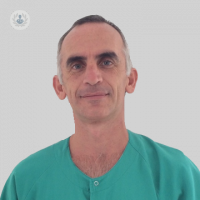Guided surgery on knee
Written by:The knee replacement operation through guided surgery allows an accuracy of 0.5 mm and 0.5 degrees on the placement of the prosthesis. Guided surgery reduces risk and increases the accuracy, allows to know exactly how the patient enters the operating room and how it will come out.

What is guided surgery?
Traditional surgery needs to have some anatomical references in the patient's bone to the prosthesis but the accuracy of this depends on the skill of the surgeon. During the computer-guided surgery calls with a pointer that references a series of knee and leg that are sent to your computer for this virtually reproduce a three-dimensional model of the patient's knee is taken. All steps to follow when making bone cuts are made first on the computer virtually and then the browser guides the surgeon during the operation. The procedure and the wound are the same as in conventional surgery, but with the guarantee of getting the best placement of the prosthesis for each patient.
Patients eligible for guided surgery
Any patient who has a knee wear that causes chronic pain and lost quality of life can be operated in a knee prosthesis with this technology. Even those patients by standard procedures are more difficult or impossible to have surgery and a hip replacement or nail femur in the leg, they could be operated without first removing avoiding having intermediate intervention.
Currently browser guided surgery can be applied in operations hip, shoulder, spine and knee in the Traumatology .
Advantages of guided surgery on knee
- Precision and accuracy. Allows the two main goals of surgery. Ensure that the prosthesis is aligned and balanced and that works in the best way possible.
- Homogenizes the results both among surgeons of the same hospital as different operations of the same surgeon.
- Solves difficult cases because the simulator always leads along the best path for each situation.
- The patient will always have an optimal result from the mechanical and functional point of view.
- There is a likelihood that the prosthesis lasts longer. Prostheses are not perennial but the more accurate are placed more will last in time.
Postoperative
Postoperative is the same as for conventional surgery. The patient should be two days in the hospital. The first day can already walk and the second can begin rehabilitation.



